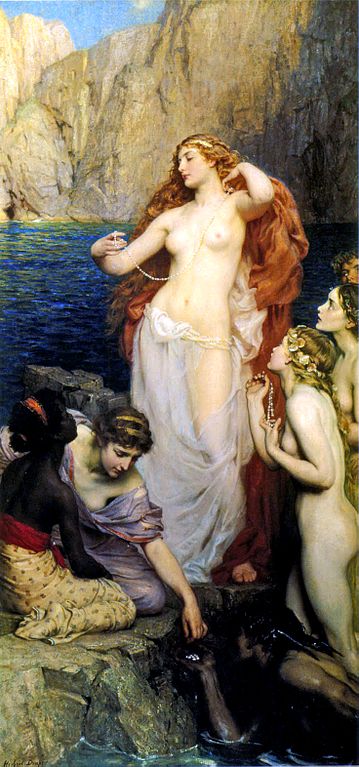Hymn to Aphrodite – Sappho – Ancient Greece – Classical Literature
(Lyric Poem, Greek, c. 570 BCE, 28 lines)
Introduction | Back to Top of Page |
“Hymn to Aphrodite” (sometimes referred to as “Ode to Aphrodite” or “Fragment 1”) is the only poem of the ancient Greek lyric poet Sappho to survive in its entirety. Although she is recorded in antiquity as producing many books of poetry, very little of her work has survived intact, and the only reason we have this complete poem is because a Roman orator called Dionysus (who lived in Rome about 30 BCE) quoted it in full in one of his own works.
Synopsis | Back to Top of Page |
 “Hymn to Aphrodite” begins with the unidentified speaker calling on the immortal goddess Aphrodite, daughter of the mighty Zeus, the use her unique skills to ensnare a reluctant lover. She entreats the goddess not to ignore her pleadings and so break a heart which is already stricken with grief.
“Hymn to Aphrodite” begins with the unidentified speaker calling on the immortal goddess Aphrodite, daughter of the mighty Zeus, the use her unique skills to ensnare a reluctant lover. She entreats the goddess not to ignore her pleadings and so break a heart which is already stricken with grief.
The author reminds Aphrodite of her devotion in the past and of the songs that have been sung in her honour, and of how the goddess has previously heard and answered the speaker’s pleas and made the trip from her father’s golden palace to this mortal’s more humble home.
It is only when Aphrodite replies in the fifth stanza that it becomes clear that it is Sappho herself who is seeking the goddess’ intervention. In the sixth stanza, although it is not clear whether the disinclined lover is in fact a man or a woman, Aphrodite assures Sappho that although he/she maybe reluctant now, he/she will soon come around and return Sappho’s love in equal measure.
The final stanza repeats Sappho’s pleas for Aphrodite to fight on her behalf and to allay her misery.
Analysis | Back to Top of Page |
 Although we have no specific date for its composition, the poem would have been composed some time in the early 6th Century BCE. Sappho used to organize a group of her young female students into a “thiasos”, a cult that worshipped Aphrodite with songs and poetry, and “Hymn to Aphrodite”was most likely composed for performance within this cult.
Although we have no specific date for its composition, the poem would have been composed some time in the early 6th Century BCE. Sappho used to organize a group of her young female students into a “thiasos”, a cult that worshipped Aphrodite with songs and poetry, and “Hymn to Aphrodite”was most likely composed for performance within this cult.
The poem consists of a plea, in seven four-line stanzas of her own Sapphic metre, from Sappho to Aphrodite to help secure the ardour of a reluctant lover, and (uniquely among such works) the goddess’s response to the poet’s plea. It points out that the goddess has helped the poet many times in the past, and Aphrodite’s personal response, suggesting almost an intimacy with her devotee, is positive and hopeful.
Resources | Back to Top of Page |
- Modern 1997 translation by Elizabeth Vandiver (Diotima): http://www.stoa.org/diotima/anthology/vandiver.shtml
- Original Greek and a variety of different English translations from the 8th and 19th Century (Classic Persuasion): http://classicpersuasion.org/pw/sappho/sape01u.htm

